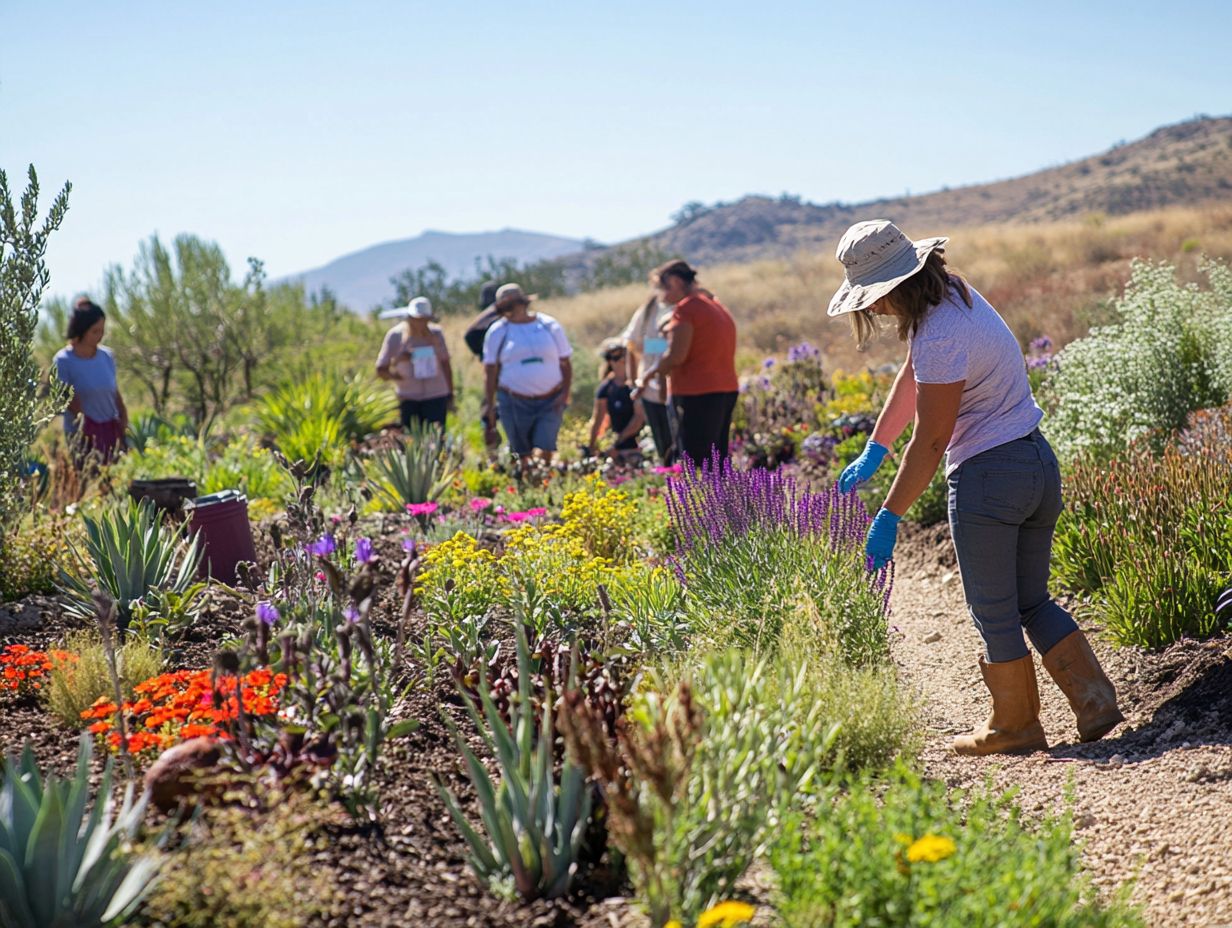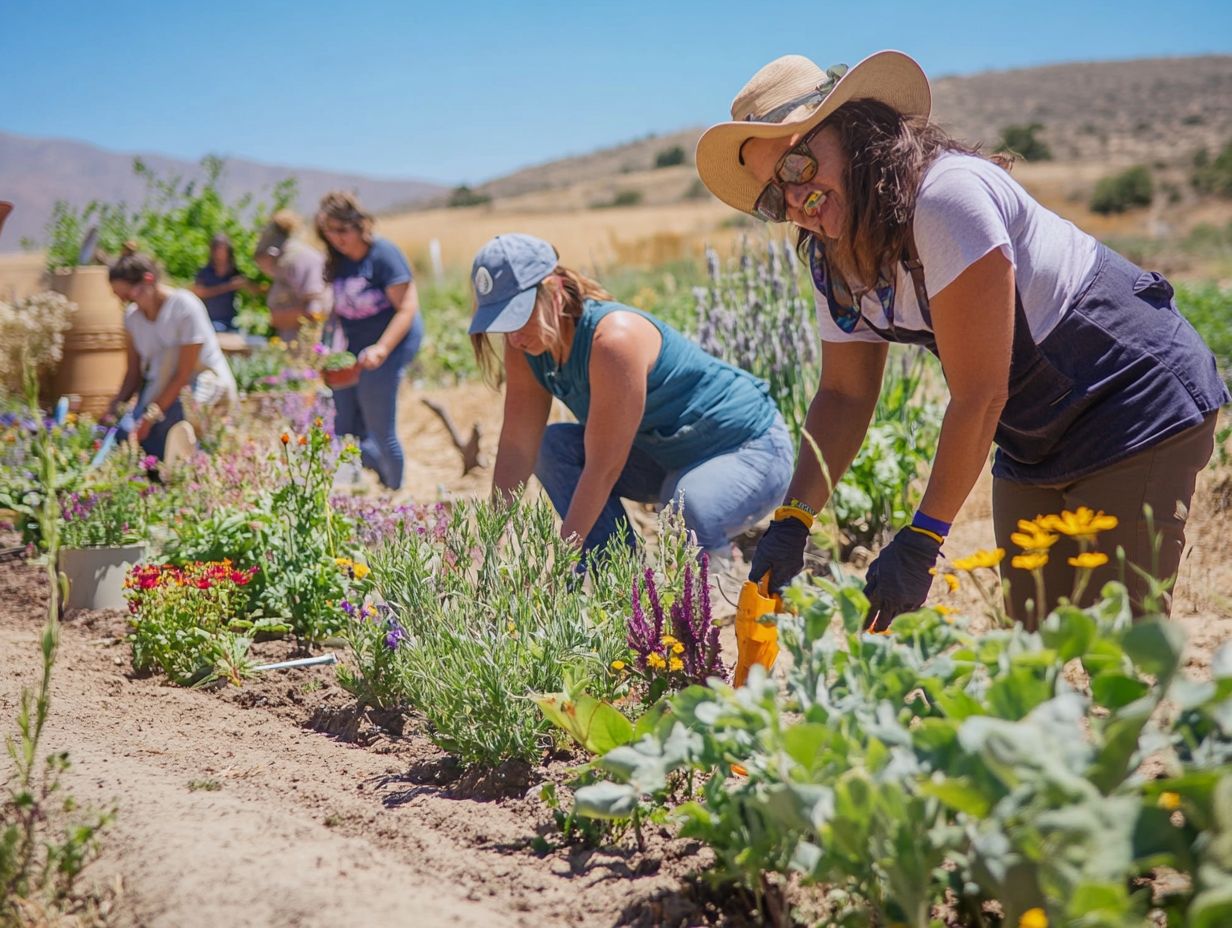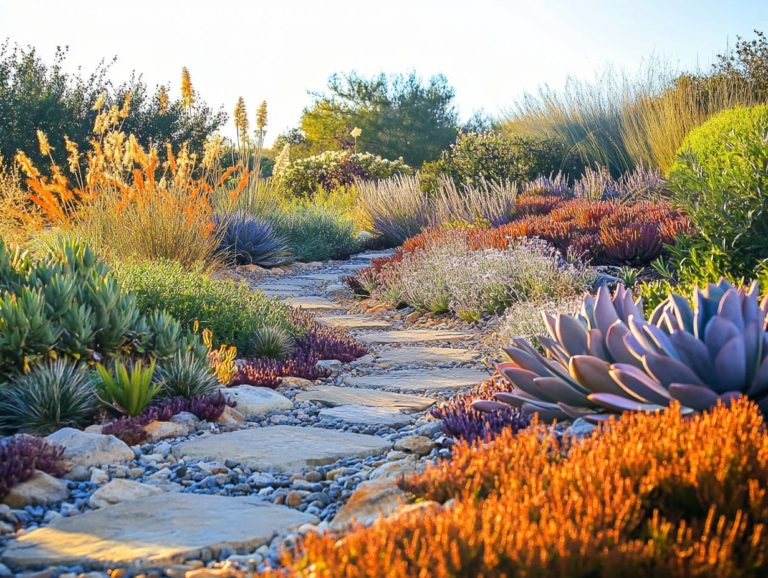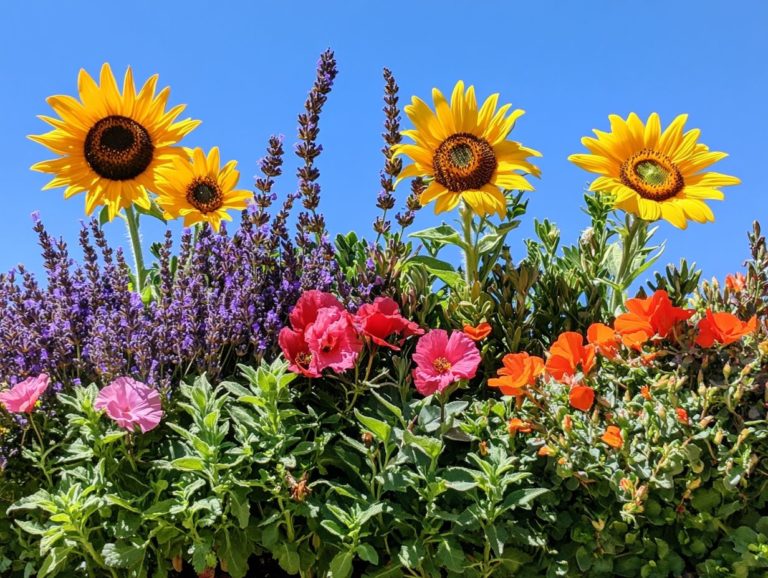5 Ways Drought Gardening Benefits Your Community
Drought gardening transcends a mere response to water scarcity; it represents a transformative approach that enriches both the environment and local communities.
By adopting techniques that conserve water and champion sustainability, you not only help preserve native plant species but also provide fresh produce for your neighborhood.
This exploration delves into the myriad benefits of drought gardening, highlighting how it cultivates a sense of community while dispelling common misconceptions.
Uncover the ways you can engage and create a meaningful impact!
Contents
- Key Takeaways:
- 1. Saves Water
- 2. Promotes Sustainable Gardening Practices
- 3. Helps Preserve Local Plant Species
- 4. Provides Fresh Produce for the Community
- 5. Creates a Sense of Community
- What Is Drought Gardening and How Does It Work?
- Frequently Asked Questions
- What is drought gardening and how does it benefit my community?
- What are the top 5 ways that drought gardening benefits my community?
- Are there any specific plants or techniques that are recommended for drought gardening?
- Can anyone practice drought gardening, regardless of location?
- Is there a learning curve for practicing drought gardening?
- How can I get my community involved in drought gardening?
Key Takeaways:

- Conserves water, a precious resource, while still allowing for beautiful and productive gardens.
- Encourages environmentally-friendly gardening practices that help reduce the impact of droughts on local ecosystems.
- Preserves and promotes the growth of local plant species, maintaining biodiversity and supporting the local ecosystem.
1. Saves Water
Water conservation is vital, especially during drought periods made worse by events like El Ni o. It helps lower your water bills and promotes sustainable gardening practices that enhance soil health and keep your garden flourishing in Massachusetts.
By adopting strategies such as watering in the early morning, you can significantly cut down on evaporation rates. This ensures that more water reaches the soil where your plants need it the most.
Utilizing automatic watering systems provides a seamless way to manage water flow, minimizing waste and boosting efficiency. Deep watering techniques promote stronger root development, enabling your plants to better endure dry spells.
Incorporating compost and mulch into your landscaping not only helps retain moisture but also enriches the soil, making it more resilient. By employing these combined strategies, you can cultivate robust gardens that thrive even amid challenging weather conditions.
2. Promotes Sustainable Gardening Practices
Sustainable gardening practices, such as incorporating drought-resistant (plants that can survive with little water) and native plants, are essential for cultivating a vibrant garden that nurtures soil health and local biodiversity while adapting to the ever-changing climate.
By choosing these types of plants, you not only boost your garden’s resilience against unpredictable weather but also create a welcoming habitat for local wildlife, from pollinators to beneficial insects.
Using compost and mulch helps enrich your soil’s nutrient profile, enhance its structure, and improve moisture retention, ultimately allowing for less frequent watering. Your sustainable garden will flourish while requiring fewer resources, all the while making a positive impact on the environment. This approach beautifully exemplifies the harmonious balance between aesthetic appeal and ecological responsibility.
3. Helps Preserve Local Plant Species
Preserving local plant species in Massachusetts is essential not just to maintain biodiversity but also to cultivate healthy environments that can survive during droughts and withstand the challenges of climate fluctuations, such as El Ni o.
These native plants are crucial resources for various wildlife and play a significant role in stabilizing soil and water systems. By incorporating drought-tolerant species into your landscaping, you will help ease the stress on water supplies during dry spells, benefiting both urban and rural areas alike.
Community gardens serve as invaluable sanctuaries for these resilient plants, allowing you and your neighbors to engage in the preservation of your region’s unique flora. Such spaces not only showcase the beauty of native varieties but also create vital habitats for pollinators like bees and butterflies, which face increasing threats from habitat loss.
By fostering these gardens, you contribute to a healthier ecological balance and promote sustainable practices within your community.
4. Provides Fresh Produce for the Community

Gardening provides fresh produce for your community. This enhances food security and offers therapeutic benefits for your physical and mental health through horticultural therapy, which uses gardening activities to improve mental well-being.
Community gardens are essential spaces where you can connect with your neighbors. You can share the joys of cultivating your own fruits and vegetables and exchange harvests, amplifying your sense of belonging.
These collective efforts increase access to nutritious food and foster friendships and collaboration among diverse groups. The act of growing together alleviates stress and promotes emotional well-being, acting as a form of therapy that encourages you to bond with the earth and those around you.
By involving various demographics, community gardens enable everyone to engage in sustainability efforts, reinforcing social ties and creating vibrant, resilient communities.
5. Creates a Sense of Community
Gardening cultivates a profound sense of community by bringing people together to collaborate, exchange knowledge, and nurture their gardens. This shared endeavor enhances social interactions and support networks while promoting mental well-being through the therapeutic benefits of horticulture.
In these collaborative efforts, relationships flourish just as beautifully as the plants themselves. Community gardens often host various events, such as harvest festivals, workshops on sustainable practices, and cooking classes that showcase the bounty grown by participants.
Imagine a local garden organizing a Seed Swap Day . You can exchange seeds and share invaluable tips on growing techniques. This sparks conversations and partnerships while strengthening the bonds between gardeners.
It invites a diverse array of community members to join in, creating an inclusive environment ripe for shared learning and growth.
What Is Drought Gardening and How Does It Work?
Drought gardening is a sophisticated approach that emphasizes cultivating plants specifically adapted to flourish in low-water conditions. This method incorporates practices designed to conserve soil health and minimize reliance on irrigation, making it particularly vital in regions impacted by phenomena such as El Ni o.
As the challenges of climate change and water scarcity escalate, this strategy sustains local ecosystems and fosters biodiversity. Gardeners often choose a diverse array of drought-resistant and native species, which have evolved to endure with minimal moisture, resulting in resilient landscapes that demand less maintenance.
Techniques such as mulching to retain soil moisture, implementing efficient drip irrigation systems, and enhancing soil structure through composting are essential tools in this practice. By embracing drought gardening, you contribute to environmental sustainability while enjoying the beauty of vibrant, flourishing gardens, even amid dwindling water resources.
What Are the Key Principles of Drought Gardening?
The key principles of drought gardening focus on maximizing water efficiency, enhancing soil health, and selecting drought-resistant plants. This approach helps you reduce the ecological footprint of your gardening practices.
By employing water conservation techniques, you can minimize waste through methods like drip irrigation and mulching. These methods retain moisture while improving soil quality over time.
Incorporating organic matter into your soil management practices enhances water retention and promotes beneficial microbial activity. Opting for native or drought-adapted species ensures your garden remains vibrant, even under challenging conditions.
These plants typically require less water and maintenance, fostering a resilient ecosystem that can withstand periods of low rainfall without significant impact.
Start your gardening journey today and discover the joy of nurturing a thriving garden that benefits both you and your community!
What Are the Different Techniques Used in Drought Gardening?

Drought gardening offers a suite of techniques designed to enhance moisture retention and safeguard plant health during dry spells. By employing methods such as early morning watering, automatic watering systems, and deep watering practices, you can significantly boost your garden s resilience.
These strategies aim to minimize water evaporation while maximizing moisture availability in the soil. Early morning watering allows your plants to absorb water efficiently, long before the sun’s intensity ramps up and accelerates evaporation.
Automatic watering systems, like drip irrigation, deliver water directly to the base of the plants, reducing wastage and ensuring precise hydration. Deep watering encourages roots to stretch deeper into the soil, enhancing the plants’ ability to withstand drought conditions.
Adding a layer of mulch serves as an insulating barrier that protects the soil and minimizes surface water loss.
To implement these techniques effectively, regularly monitor soil moisture and adjust your watering schedule according to the season and the specific needs of your plants. This proactive approach will not only conserve water but also promote a thriving garden, even in the driest conditions.
How Can Drought Gardening Benefit the Environment?
Drought gardening presents a wealth of environmental advantages, enhancing soil health, conserving water, and providing essential habitats for pollinators—all of which elevate local ecosystems and biodiversity. Additionally, understanding the economic benefits of drought-resistant gardening can further support sustainable practices.
Focusing on drought tips can greatly aid in achieving your gardening goals. By thoughtfully selecting drought-resistant plants and designing landscapes that maximize water efficiency, you can play a pivotal role in resource conservation.
This approach not only minimizes the need for irrigation but also aids in maintaining the vitality of local water sources. Emphasizing garden maintenance using techniques like deep watering can further enhance your garden’s resilience.
Crafting a vibrant habitat with native flora attracts crucial pollinators like bees and butterflies, both of which are essential for food production and ecological equilibrium.
By employing strategic planting techniques, including the use of drought-tolerant plants like Agave and radishes, you can bolster these populations. This ensures their flourishing amidst changing climatic conditions and supports the intricate web of life that relies on their presence.
What Are Some Common Misconceptions About Drought Gardening?
Don’t let myths hold you back! Common misconceptions about drought gardening often lead you to believe that it requires sacrificing plant beauty or productivity. In reality, it can pave the way for sustainable gardening practices that foster resilience and diversity.
By selecting the right mix of drought-resistant plants, you can create a garden that not only thrives in challenging conditions but also captivates with its aesthetic appeal. For example, incorporating native plants like lavender, succulents, monstera, and Christmas cactus will conserve water while introducing a vibrant array of colors and textures.
Utilizing techniques such as mulching and adding organic matter, including compost, can significantly enhance soil health. This promotes vibrant growth and bountiful yields.
Engaging in successful drought gardening not only benefits the environment but also rewards you with stunning landscapes that celebrate the beauty of resilience. For seniors, this practice offers additional perks, as highlighted in the benefits of drought gardening for seniors, while also helping to lower water bills.
Start implementing these drought gardening techniques in your garden today and witness the transformation!
How Can One Get Involved in Drought Gardening in Their Community?
Getting involved in drought gardening within your community starts by immersing yourself in local organizations and attending workshops. Participate in community garden projects that prioritize water conservation and the cultivation of native plants. Knowledge sharing in these communities enhances understanding of local ecology and promotes gardening benefits.
By connecting with groups like UMass Extension or the New England Botanic Garden, you can uncover valuable resources and acquire hands-on experience. These organizations frequently host various events, including those related to gardening as therapy. You can attend enlightening lectures on the advantages of drought-resistant plants or participate in community clean-up days that promote teamwork and environmental stewardship.
Engaging in these activities sharpens your gardening skills and fortifies community ties. They foster networks of support and shared knowledge. Don t miss this exciting opportunity to connect with local experts and fellow enthusiasts who share your passion for sustainable practices and resources related to Robert Burgess featured in the Boston Globe and Telegram & Gazette.
Frequently Asked Questions

What is drought gardening and how does it benefit my community?
Drought gardening is a method that uses plants and techniques specifically designed to conserve water. By practicing this approach and implementing five ways to enhance drought landscapes, you help your community by conserving water and reducing the strain on local resources, especially during events influenced by El Niño.
What are the top 5 ways that drought gardening benefits my community?
- Water conservation: Using drought gardening techniques, like automatic watering systems, significantly reduces water needed to maintain your garden.
- Reduced strain on water resources: Drought gardening lowers the demand for water, alleviating pressure on local supplies during dry periods.
- Encourages sustainability: It promotes sustainable practices, such as using drought-resistant plants and mulching, creating a more resilient ecosystem.
- Creates green spaces: Transform barren areas into beautiful green spaces that enhance overall aesthetics and quality of life.
- Promotes community involvement: Bring people together as neighbors share tips, resources, and plant cuttings while working on shared gardens.
Are there any specific plants or techniques that are recommended for drought gardening?
Yes, many drought-tolerant plants are recommended for drought gardening, such as succulents, cacti, and native grasses. Techniques like mulching, drip irrigation (a method of watering plants directly at their roots), and soil amendment help conserve water while enhancing soil health.
Can anyone practice drought gardening, regardless of location?
Yes, anyone can practice drought gardening, but specific plants and techniques may vary depending on your location and climate. It s important to research and choose plants that are native or well-adapted to your region for the best results, especially in Massachusetts.
Is there a learning curve for practicing drought gardening?
Like any new skill, there can be a learning curve in drought gardening. However, many online resources, classes, and community gardens, including connections with the American Horticultural Therapy Association, can provide guidance and support for beginners. With some research and practice, anyone can become a successful drought gardener.
How can I get my community involved in drought gardening?
One way to engage your community is by starting a community garden or joining an existing one. Learn about the importance of community gardens in drought areas to get your community excited about drought gardening!
Share your knowledge and resources through workshops on the advantages of gardening. You might also highlight climate change and drought gardening benefits to encourage your local government to support drought gardening initiatives in your area.






